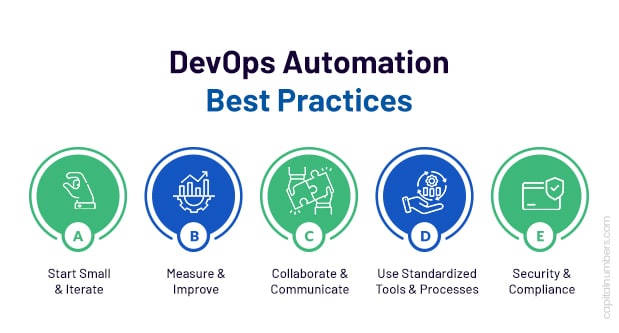DevOps Automation Best Practices: Tips for Success
Table of Contents
DevOps automation is the practice of using technology to automate tasks in the software development lifecycle, such as building, testing, deployment, and operations. This automation helps organizations increase efficiency, reduce errors, and accelerate software delivery.
In this blog, we’ll explore key DevOps automation best practices that can help you optimize your custom software development projects. By following these practices, you can improve the quality, speed, and efficiency of your software delivery.
Why is DevOps Automation Important?
Accelerating Software Delivery:
- Faster Time-to-Market: DevOps automation streamlines the development and deployment process, enabling organizations to deliver new features and updates more quickly.
- Reduced Lead Time: Automation helps reduce the time it takes to go from code commit to production, allowing teams to respond to market changes and customer feedback more rapidly.
Reducing Errors and Improving Quality:
- Fewer Manual Errors: Automation minimizes the risk of human error, leading to fewer defects and a higher-quality product.
- Consistent Processes: Automated workflows ensure that processes are followed consistently, reducing the likelihood of errors and inconsistencies.
- Early Detection of Issues: Automated testing and monitoring can help identify and address issues early in the development process.
Enhancing Team Collaboration:
- Breaking Down Silos: DevOps automation promotes a culture of collaboration and shared responsibility between development and operations teams.
- Improved Communication: Automation provides a common platform for teams to track progress, share information, and identify areas for improvement.
- Shared Ownership: When teams are empowered to automate processes, they take ownership of the entire software delivery lifecycle.
Increasing Scalability and Reliability:
- Scalable Infrastructure: DevOps automation enables organizations to scale their infrastructure up or down to meet changing demands.
- Reliable Deployments: Automated deployment processes reduce the risk of human error and ensure consistent and reliable deployments.
- Fault Tolerance: Automation can help build systems that are more resilient to failures and can recover from disruptions.
By implementing DevOps automation, organizations can achieve significant benefits in terms of speed, quality, collaboration, and scalability.
Core DevOps Automation Principles
Continuous Integration (CI) and Continuous Delivery (CD)
CI/CD pipelines automate the process of building, testing, and deploying software. This ensures that code changes are integrated and tested frequently, reducing the risk of errors and improving software quality.
- Setting up CI/CD pipelines: Use tools like Jenkins, CircleCI, or GitLab CI/CD to define and automate your CI/CD pipelines.
- Automated testing and code quality checks: Integrate automated tests (unit, integration, and end-to-end) to catch defects early in the development process. Use tools like JUnit, TestNG, or Selenium for testing.
- Continuous deployment strategies: Implement strategies like blue-green deployments or canary releases to minimize risk and ensure a smooth transition to production.
Infrastructure as Code (IaC)
IaC involves defining and managing infrastructure using code, allowing for version control, reproducibility, and automation.
- Defining infrastructure using code: Use tools like Terraform, CloudFormation, or Ansible to define your infrastructure resources (e.g., servers, networks, storage) as code.
- Benefits of IaC:
- Consistency: Ensure that your infrastructure is consistent across different environments.
- Reproducibility: Easily recreate infrastructure configurations.
- Version control: Track changes to your infrastructure using version control systems.
- Popular IaC tools: Terraform, CloudFormation, Ansible, Puppet, Chef.
Configuration Management
Configuration management involves managing and automating the configuration of software and infrastructure components.
- Managing configuration settings and dependencies: Use configuration management tools to define and manage configuration settings, dependencies, and relationships between components.
- Popular configuration management tools: Ansible, Puppet, Chef.
Containerization
Containerization involves packaging applications and their dependencies into containers, which can be run consistently across different environments.
- Using Docker and Kubernetes: Docker is used to create and manage containers, while Kubernetes is used to orchestrate and manage containerized applications.
- Benefits of containerization:
- Portability: Containers can be easily moved between different environments.
- Isolation: Containers provide isolation between applications, reducing the risk of conflicts.
- Scalability: Containers can be easily scaled up or down to meet demand.
Monitoring and Logging
- Collecting and analyzing performance metrics: Use tools like Prometheus, Grafana, and ELK Stack to collect and analyze performance metrics such as CPU usage, memory consumption, and response times.
- Identifying and resolving issues: Use monitoring data to identify performance bottlenecks, errors, and other issues.
- Alerting: Set up alerts to notify teams of critical issues.
By effectively implementing these DevOps automation principles and utilizing the right tools, organizations can streamline their software development processes, improve efficiency, and deliver high-quality software.
You May Also Read: A Step-by-Step Guide for Deploying Laravel Applications on Kubernetes
DevOps Automation Best Practices

1. Start Small and Iterate:
- Begin by automating simple tasks that can provide immediate benefits, such as building and testing.
- Gradually expand your automation efforts as you gain confidence and identify additional opportunities.
- Break down complex tasks into smaller, manageable steps to avoid overwhelming your team.
2. Measure and Improve:
- Monitor and analyze key metrics: Track metrics such as deployment frequency, lead time, and mean time to repair (MTTR).
- Identify bottlenecks and areas for improvement: Use data-driven insights to identify inefficiencies and optimize your automation processes.
- Continuously refine and improve your automation practices: Make iterative changes based on your analysis and feedback.
3. Collaborate and Communicate:
- Foster a culture of collaboration: Encourage open communication and teamwork between development and operations teams.
- Establish clear communication channels: Use tools like Slack, Teams, or Jira to facilitate effective communication.
- Encourage knowledge sharing: Promote a culture of learning and sharing best practices.
4. Use Standardized Tools and Processes:
- Adopt industry-standard tools: Use popular DevOps tools like Jenkins, GitLab CI/CD, Ansible, and Docker.
- Standardize processes: Define clear guidelines and procedures for your automation workflows.
- Ensure consistency: Maintain consistency across different teams and projects to avoid confusion and errors.
5. Security and Compliance:
- Prioritize security: Implement security measures to protect sensitive data and prevent unauthorized access.
- Comply with regulations: Ensure that your automation processes comply with relevant industry regulations (e.g., GDPR, HIPAA).
- Conduct regular security audits: Conduct regular security audits to identify and address vulnerabilities.
By following these best practices, you can effectively implement DevOps automation and reap the benefits of improved efficiency, quality, and delivery speed. To maximize the impact of your automation initiatives, consider partnering with experts who can guide you through the process. DevOps consulting services provide tailored strategies, tools, and support to help your organization adopt best practices, overcome challenges, and ensure smooth and scalable automation throughout your development lifecycle.
Common Pitfalls to Avoid in DevOps Automation
Over-automation:
- Avoid automating everything: Focus on automating tasks that provide the most significant benefits and can be effectively automated.
- Consider the complexity: Evaluate whether the benefits of automating a task outweigh the potential drawbacks and complexity.
- Prioritize automation: Prioritize tasks for automation based on their impact on efficiency, quality, and time-to-market.
Ignoring Feedback Loops:
- Implement automated feedback mechanisms: Use tools and processes to collect feedback on automated tasks and identify areas for improvement.
- Monitor performance metrics: Track key performance indicators (KPIs) to assess the effectiveness of your automation efforts.
- Continuously refine your automation processes: Make adjustments based on feedback and data to ensure optimal performance.
Manual Interventions in Automated Processes:
- Minimize manual intervention: Aim to automate as many tasks as possible to reduce the risk of human error and inconsistencies.
- Standardize processes: Define clear guidelines and procedures for automated tasks to minimize manual intervention.
- Train team members: Ensure that team members are adequately trained on automation tools and processes to reduce the need for manual intervention.
Not Scaling Automation:
- Plan for growth: Ensure that your automation infrastructure can scale to accommodate increasing workloads.
- Review and update automation scripts: Regularly review and update your automation scripts to ensure they remain efficient and effective.
- Utilize cloud-based solutions: Consider using cloud-based platforms for scalability and flexibility.
By avoiding these common pitfalls, you can effectively implement DevOps automation and maximize its benefits.
You May Also Read: 5 Reasons Why You Need a Product Owner to Maximize Your Project’s Potential
Conclusion
DevOps automation offers significant benefits for organizations, including accelerated software delivery, reduced errors, improved quality, enhanced collaboration, and increased scalability. By implementing key DevOps automation principles like CI/CD, IaC, configuration management, containerization, monitoring, and following best practices, organizations can streamline their software development processes and achieve these goals.
To successfully implement DevOps automation, it’s essential to start small and iterate, measure and improve, collaborate and communicate, use standardized tools and processes, and prioritize security and compliance. By avoiding common pitfalls like over-automation, ignoring feedback loops, manual interventions, and not scaling automation, organizations can maximize the benefits of DevOps automation and achieve long-term success.
Ready to transform your software development process? Let our DevOps experts help you streamline your workflows, improve efficiency, and accelerate time-to-market. Contact us today for a free consultation and discover how DevOps automation can benefit your organization.














